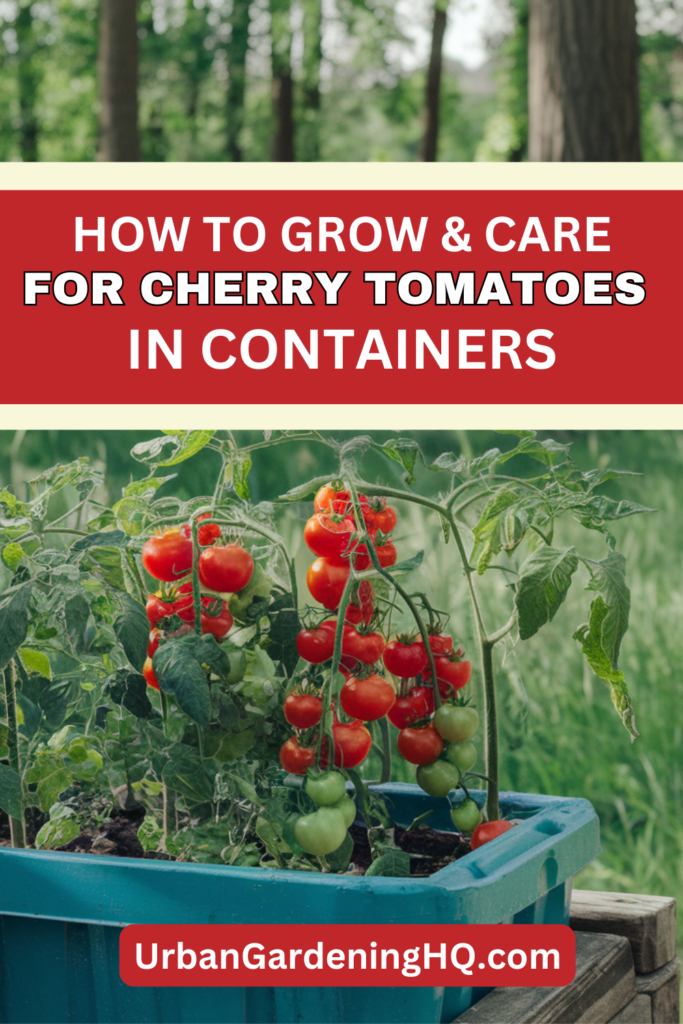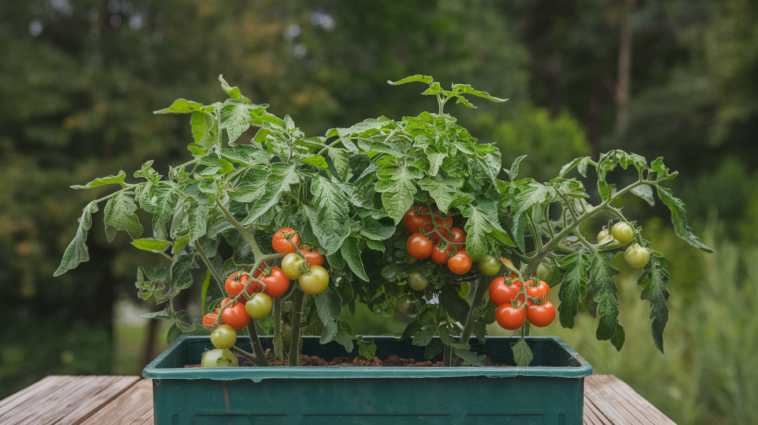Cherry tomatoes are one of my favorite vegetables to grow in containers. They’re easy to care for, produce an abundance of sweet, juicy fruits, and are perfect for small spaces. Over the years, I’ve fine-tuned my process to get the best results, and I’m excited to share my tips with you.
Choosing the Right Container
Tomatoes have deep roots, so I make sure to use a container that is at least 12 inches deep and 14 inches wide. Larger pots help retain moisture and prevent the soil from drying out too quickly. I prefer fabric grow bags, ceramic pots, or plastic containers with plenty of drainage holes to prevent root rot.
If I’m growing multiple plants, I space them at least 18 inches apart to allow for proper airflow, which helps prevent disease. For better mobility, I sometimes use containers with wheels, making it easier to move them around based on sunlight needs.

Picking the Best Cherry Tomato Variety
Not all cherry tomato varieties are well-suited for container gardening, so I choose compact, high-yielding types. Some of my favorites include:
- ‘Tiny Tim’ – A dwarf variety that thrives in small pots.
- ‘Tumbling Tom’ – A cascading variety that looks beautiful in hanging baskets.
- ‘Sun Gold’ – Sweet, golden cherry tomatoes that produce heavily.
- ‘Super Sweet 100’ – A prolific grower with long clusters of juicy fruit.
- ‘Patio Princess’ – A bush variety bred specifically for small spaces.
Preparing the Soil
Cherry tomatoes need rich, well-draining soil to thrive. I use a high-quality potting mix with added compost for nutrients. To improve drainage, I mix in perlite or coconut coir.
Before planting, I also add organic slow-release fertilizer or compost to ensure the plants get a steady supply of nutrients throughout the growing season. I avoid using garden soil, as it compacts easily and may contain pests or diseases.
Planting Cherry Tomatoes
I plant cherry tomato seedlings deeply, burying at least two-thirds of the stem. This encourages the plant to develop a strong root system. If I’m starting from seed, I sow them indoors 6-8 weeks before the last frost and transplant once they’re about 6 inches tall.
To support healthy growth, I place a tomato cage, stakes, or a trellis in the container at planting time. This helps the plant stay upright and keeps fruit off the ground. I also gently remove the lower leaves to prevent soil-borne diseases from splashing onto the plant.
Watering and Mulching
Tomatoes need consistent watering to prevent issues like blossom-end rot. I water deeply 2-3 times a week, keeping the soil evenly moist but not soggy. During hot weather, I check daily to ensure they don’t dry out.
To retain moisture, I apply a layer of mulch around the base, using straw, shredded leaves, or coconut husks. This also helps regulate soil temperature and prevents weeds. When watering, I try to avoid wetting the leaves to reduce the risk of fungal infections.
Sunlight and Temperature
Cherry tomatoes love full sun, so I place my containers in a spot that gets at least 6-8 hours of direct sunlight per day.
They thrive in temperatures between 70°F and 85°F. If temperatures exceed 90°F, I provide some afternoon shade to prevent stress. For chilly nights, I cover my plants with a light cloth to keep them warm. If the weather becomes extremely hot, I mist the plants in the early morning to help them stay cool.
Fertilizing for Maximum Growth
To keep my plants healthy and productive, I fertilize every two weeks with an organic liquid fertilizer or compost tea. I avoid high-nitrogen fertilizers, as they encourage leafy growth at the expense of fruit production.
Once the plants start flowering, I switch to a phosphorus-rich fertilizer to support fruit development. I also add Epsom salt (magnesium sulfate) occasionally to prevent yellowing leaves and promote strong growth.
Preventing Pests and Diseases
Tomatoes can attract pests and diseases, but I keep an eye out and take preventative measures:
- Aphids & Whiteflies – I spray with neem oil or introduce ladybugs.
- Hornworms – I handpick them or use Bt (Bacillus thuringiensis) to control them.
- Blossom-end Rot – I maintain consistent watering and add calcium if needed.
- Powdery Mildew & Blight – I ensure good airflow, avoid overhead watering, and remove affected leaves.
Companion planting also helps—I grow basil, marigolds, or nasturtiums nearby to deter pests naturally. These plants not only help keep bugs away but also enhance the flavor of my tomatoes!
Harvesting Cherry Tomatoes
One of the best parts of growing cherry tomatoes is the continuous harvest. Once the fruits turn fully red (or their designated color), I gently twist or snip them off the vine. Picking regularly encourages the plant to keep producing.
If I harvest underripe tomatoes, I let them ripen indoors at room temperature. Avoid putting them in the fridge, as cold temperatures can reduce their flavor and texture.
Storing and Using Cherry Tomatoes
Cherry tomatoes are best enjoyed fresh, but if I have an abundance, I store them at room temperature for up to a week. For longer storage, I roast and freeze them, make homemade sauces, or sun-dry them for later use. They also make excellent additions to salads, pasta dishes, and even homemade salsa.
Troubleshooting Common Issues
Even with the best care, cherry tomatoes sometimes face problems. Here’s how I handle a few common ones:
- Leggy Seedlings – If my seedlings grow tall and spindly, I know they need more light. I place them under grow lights or near a bright window.
- Yellowing Leaves – This can be a sign of nutrient deficiency or overwatering. I check the soil moisture and ensure my plants are getting balanced nutrients.
- Cracked Fruits – This happens when tomatoes receive inconsistent watering. I try to water evenly and apply mulch to keep moisture levels stable.
- Dropping Flowers – If blossoms fall off without forming fruit, it may be due to temperature stress or lack of pollination. I gently shake the plants to help with pollination or place them where pollinators can reach them.
Final Thoughts
Growing cherry tomatoes in containers is incredibly rewarding. Whether you have a balcony, patio, or small garden space, you can enjoy a steady supply of sweet, juicy tomatoes with just a little care and attention. If you haven’t tried it yet, I highly recommend giving it a go—happy gardening!


